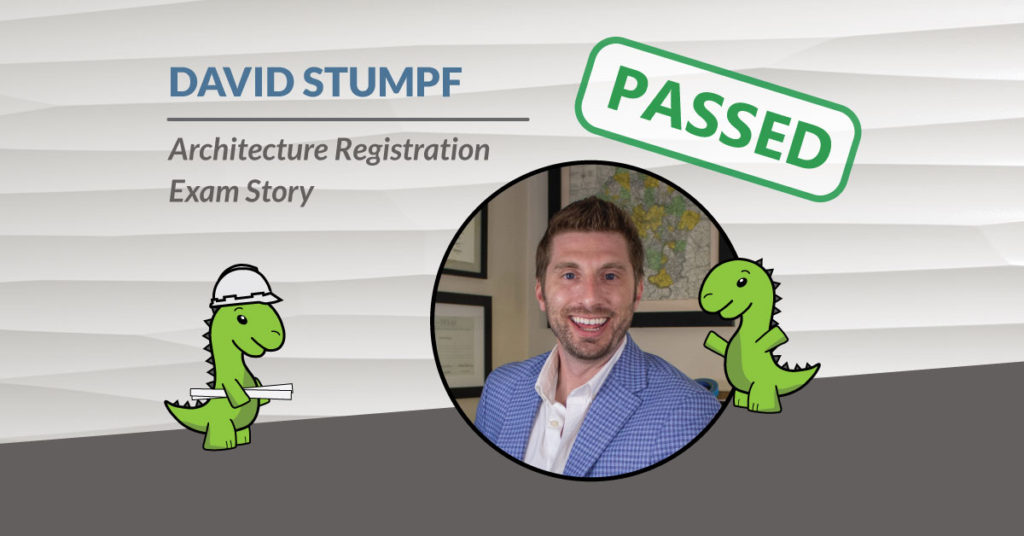Welcome to the Architectural Registration Exam (ARE) experience stories series! This series is to share experiences, timelines and advice of professionals that have completed their AREs. We know it can be a daunting task to get started and overwhelming on the number of resources out there. We hope you find this information helpful in organizing how you proceed through your exams. Good Luck!
This is the experience, timeline, and advice from:
David Stumpf, AIA, NCARB
I’m David Stumpf, a licensed architect based in Pittsburgh, Pennsylvania. I established my architecture practice in 2020 after a pandemic-related layoff. I hold licenses in New York, North Dakota, Pennsylvania, and Texas. My journey began with an undergraduate degree in Architectural Studies and a minor in Construction Management from Kent State University in 2011. Subsequently, I pursued a Master of Architecture (M.Arch III) at The University of Texas at San Antonio, graduating in 2015.
Despite persistent efforts during my education, I struggled to secure an internship or part-time position in architecture. I distributed countless resumes, cold-called firms, and personally visited numerous offices in both Pittsburgh and San Antonio, all to no avail. However, after graduating, I landed a role at Margittai Architects in Pittsburgh, where I honed my skills for two years, engaged in diverse projects, and completed my Intern Development Program and Architect Registration Exams.
In 2017, I transitioned into construction, working as a project manager for a production home builder. My next move took me to Dallas, Texas, where I joined WDG Architecture. There, I gained valuable experience working on corporate projects and large-scale buildings. Notably, I contributed to a high-rise project and designed a jewel box office building in Tampa’s Midtown development. The pandemic brought my third layoff in five years, reaffirming my decision to establish my own business. Since 2020, I’ve been operating my hybrid venture, blending architecture and social media. This platform showcases my client projects and offers educational content.
“Don’t fear failure. It’s okay if you stumble along the way. Facing adversity is a crucial part of growth and improvement.”
Exam Order
I started my first job at Margittai Architects in Pittsburgh’s Southside Neighborhood in June 2015 after completing graduate school. I initially hesitated to take my architectural exams due to self-doubt and nerves. However, the goal of becoming licensed before turning 30, encouragement from the firm owner Peter, and friendly competition with my coworkers pushed me to start. We had access to a study material library at the firm, which primarily included Kaplan books, audio lectures, and flashcards. I listened to the lectures regularly, even after becoming licensed, to stay updated on professional practice topics.
My study approach remained consistent throughout the process. I aimed to schedule an exam one month after signing up. During that month, I’d visit Starbucks, order a drip coffee, find a cozy corner, and study a chapter of my Kaplan guide for about an hour each day after work. During the day, both at the office and during my commute, I’d listen to audio recordings of professional practice lectures from the University of Chicago. I would also sign up for the next exam immediately after completing one, ensuring I stayed on track, regardless of previous test results. This method generally worked, except for a five-month break I took to save money for the remaining exams while paying off my student loans ($76k) as quickly as possible. I successfully paid off my loans, which I consider just as significant a journey as achieving architectural licensure.
Initially, I took the ARE 4.0 exams and later transitioned to the ARE 5.0, the current version of the architecture registration exam. If you’d like more details about my pass/fail experiences, feel free to ask.
| February 6, 2016 | In Person | PPP (4.0) | FAIL |
| March 5, 2016 | In Person | SITE (4.0) | PASS |
| September 24, 2016 | In Person | PPP (4.0) | FAIL |
| November 7, 2016 | In Person | CDS (4.0) | PASS |
| November 18, 2016 | In Person | PPP | PASS |
Transition to ARE 5.0
| February 27, 2017 | In Person | PDD | FAIL |
| February 28, 2017 | In Person | PPD | FAIL |
| July, 7, 2017 | In Person | PDD | PASS |
| August 7, 2017 | In Person | PPD | PASS |
Programming, Planning & Practice (PPP)
Construction Documents & Services (CDS)
Site Planning & Design (Site)
Advice for you!
I often get asked “why do I need to get licensed?”. Why did you decide that you wanted to be a licensed Architect?
Why should you get licensed? Put simply, without a license, you’re not legally an architect, and this misrepresentation can have professional consequences. I’m passionate about this because I own and operate an architecture firm and often compete with unlicensed individuals in my practice area.
I realized the importance of licensure during my college years, which were a bit of an identity crisis for me. The licensing process wasn’t well understood back then, and my university didn’t clarify that the undergraduate degrees they offered didn’t qualify as professional degrees. Licensure is vital as it protects the profession, defines who we are to the public, ensures the safety of the public, and enhances our job prospects.
Initially, I contemplated being a home designer instead of pursuing further education, but I realized this path limited my capabilities, relegating me to a mere draftsman. Operating without a license confuses potential clients about your expertise and exposes you to exploitation.
If you aim for a traditional architecture career or dream of starting your own business, licensure enables you to reach greater heights. Without it, you may end up limited and function, which restricts the size and type of buildings you can design.
Moreover, working without a license exposes you to legal risks when taking on projects you’re not qualified for. I’ve personally encountered clients who were misled by unlicensed individuals claiming to be architects, resulting in problems.
In essence, licensure is the culmination of your architectural journey and a valuable asset for career advancement, whether you own a business, stamp drawings, or not.
Often people don’t know where to start, do you have any advice for those looking to start their exams -or- how did you start?
I’d recommend a similar approach to what I did. Take action without overthinking it, especially when you’re still in that study-focused mindset close to graduation. Start by exploring NCARB’s exam prep information on their website. Choose the test you feel most confident about after reading up on it, and sign up right away, setting a firm deadline (around a month from that day). With your test and time frame defined, it becomes straightforward. Simply integrate study guide reading and lecture listening into your daily schedule, and importantly, maintain your momentum. It’s easier to progress swiftly through the process than to start and stop with long breaks in between.
Additionally, don’t fear failure. It’s okay if you stumble along the way. Facing adversity is a crucial part of growth and improvement. I personally failed four exams, and I’m not hesitant to share that with you all.
What type of study materials did you use? Any particular ones that you’d recommend?
I utilized Kaplan study guides, initially for the ARE 4.0, and their adapted versions for the ARE 5.0, although they lacked specifics for the latter (still useful). I also revisited my old statics and dynamics (structures) textbook to refresh my knowledge in those areas. Additionally, I repeatedly listened to Michael Hanahan’s professional practice lectures from the University of Chicago, which contained valuable insights for each exam. You can access those lectures here.
How did you fit study time into your schedule? Was there anything in particular that worked well for you?
With an hour-long commute to and from the office, dealing with rush hour traffic and a tunnel on the east side of Pittsburgh, I utilized this time to listen to the lectures I mentioned earlier. I also established a routine of stopping at a Starbucks on my way home to read a chapter from my Kaplan study guide each night and take notes. Given my fondness for studying in the college library, this setting provided a similar atmosphere, amplified by the lively ambiance and a comforting cup of coffee that helped me stay focused and manage the studying pressure.
Do you have any other advice for someone studying for their exams?
The simplest way to study is what suits you best. It may sound cliché, but we’ve all undergone the rigorous training of architecture school, which equips us with valuable study skills. The key is to adapt the study habits perfected during our academic years to prepare for the ARE effectively. For me, stopping at Starbucks worked because, during school, I juggled being a student athlete with two jobs, necessitating a flexible yet structured schedule to accommodate my studies. Applying this mindset and tactics to my professional life proved beneficial. I believe that if everyone approaches ARE preparation like they did during their academic years (outside of studio work), it can help them establish effective study habits that work for them individually.
We hope that this information helps you through your ARE journey, setting goals, and giving you some insight on how to get started.
Thank you again to Glen Santayana for sharing your story!
Edited by
Katelyn Rossier, AIA, NCARB, LSSBB
Want to share your ARE Story?
Contact us!


